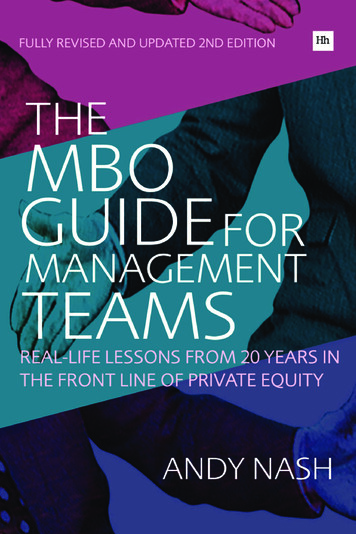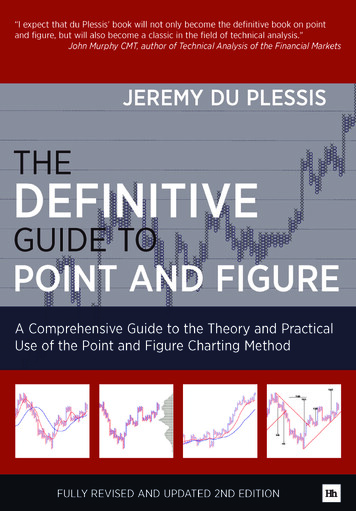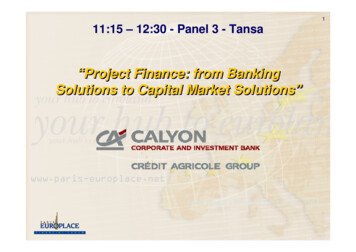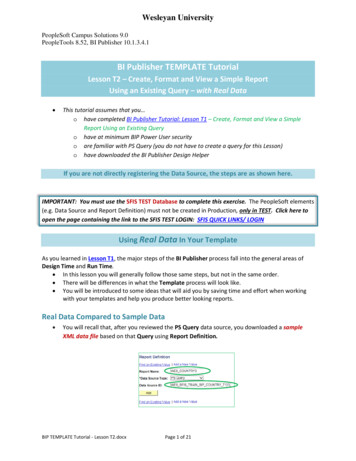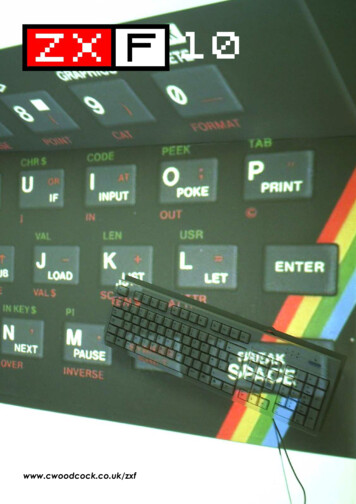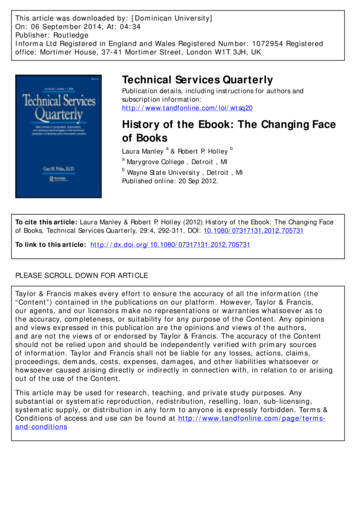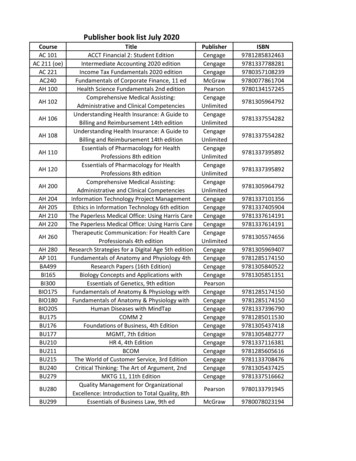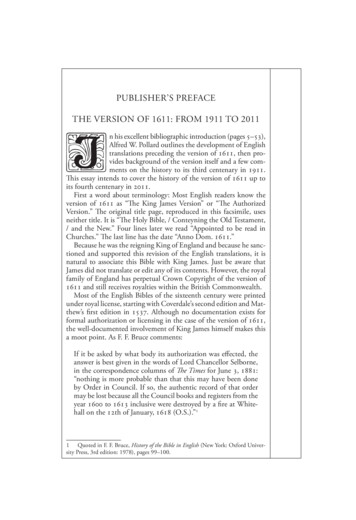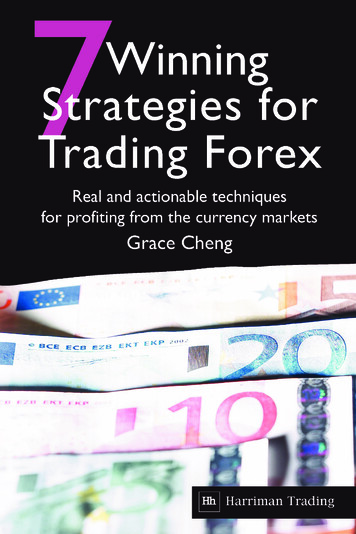
Transcription
Sample
WinningStrategies forTrading ForexReal and actionable techniquesfor profiting from the currency marketsGrace Cheng
HARRIMAN HOUSE LTD3A Penns RoadPetersfieldHampshireGU32 2EWGREAT BRITAINTel: 44 (0)1730 233870Email: enquiries@harriman-house.comWebsite: www.harriman-house.comFirst published as Hardback in Great Britain in 2007 by Harriman House.This edition published in 2011Copyright Harriman House LtdThe right of Grace Cheng to be identified as the author has been assertedin accordance with the Copyright, Design and Patents Act 1988.978-0-857190-90-1British Library Cataloguing in Publication DataA CIP catalogue record for this book can be obtained from the British Library.All rights reserved; no part of this publication may be reproduced, stored in a retrievalsystem, or transmitted in any form or by any means, electronic, mechanical,photocopying, recording, or otherwise without the prior written permission of thePublisher. This book may not be lent, resold, hired out or otherwise disposed of byway of trade in any form of binding or cover other than that in which it is publishedwithout the prior written consent of the Publisher.No responsibility for loss occasioned to any person or corporate body acting orrefraining to act as a result of reading material in this book can be accepted by thePublisher, by the Author, or by the employer of the Author.Designated trademarks and brands are the property of their respective owners.
I dedicate this book to my husband, Pedro.Thank you for your constant encouragement, support and love.This book is also dedicated to my loving parents who have alwaysbelieved in me.
ContentsAbout the AuthorviiPrefaceixIntroductionPart I: Trading Forexxiii11:Getting Started2:Spot Forex Market Structure293:How To Overcome The Odds Of Trading Forex414:The Ten Rules For Forex Trading57Part II: Strategies3615:Strategy 1 – Market Sentiment636:Strategy 2 – Trend Riding837:Strategy 3 – Breakout Fading1098:Strategy 4 – Breakout Trading1319:Strategy 5 – Decreased Volatility Breakout15310: Strategy 6 – Carry Trade17511: Strategy 7 – News Straddling189Appendices211Forex Glossary213Currency Codes225Major Regulatory Agencies232Index233v
About The AuthorGrace Cheng is an experienced, full-time forex trader who is well-versed intechnical, fundamental and sentiment analysis, which she utilises in her trading.She occasionally writes for trading and investment publications such as TechnicalAnalysis of Stocks & Commodities, The Trader’s Journal and Smart Investor, aswell as for online financial portals such as Investopedia. She has also been featuredin newspapers, magazines, newsletters and on TV.Grace is the creator of the PowerFX Course which is designed for both new andintermediate traders to jump-start their trading performance. Grace has mentoredhundreds of independent traders through her PowerFX Course.Her web site is at: www.GraceCheng.comvii
PrefaceThe global forex market, being the world’s most liquid financial market, offersmany exciting opportunities for traders to profit from exchange rate fluctuations.And the development of sophisticated online foreign exchange trading platforms inrecent years has attracted many traders to the market – traders who seek an incomein addition to their day job or those who wish to trade a new market besides stocksand futures.Who this book is forThis book is primarily for those who are new to the world of currency trading andare curious about how they can make money from the forex market. Existingtraders who are trading on demo or live accounts should also find some usefuladvice in this book.Some knowledge of candlestick charting is assumed as I will be using candlesticksto display the high, low, opening and closing prices in the charts throughout thebook.Contrary to popular belief, you don’t have to be rich in order to trade forex today.All you need to start is a computer with fast and stable internet access and arelatively small account with a broker.About this bookThis book describes seven fundamental and technical trading strategies for tradingthe foreign exchange markets. The purpose of this book is to show you how youcan trade forex with these winning strategies. I will share with you some new ideas,interesting concepts, and the nuts and bolts of how you can implement eachstrategy more effectively.This book is quite different from traditional technical analysis books because, whilethose books may document the reliability of certain technical patterns, I willexplain in this book why certain technical patterns do not work as well in the forexmarket and therefore need adapting. For example, I have increasingly noticed thatin recent times the first attempt of a price breakout more often than not results in afailure.The strategies that I am going to share with you are suitable for trading the forexmarket in any time frame – ranging from minutes to weeks. Throughout the book Ialso explain certain aspects of the forex market so that you can gain an insight intohow the market behaves.ix
7 Winning Strategies For Trading ForexEven though each strategy has its own general guidelines, do note that all thesestrategies are open to individual customisation – flexibility is one of the keyingredients of becoming a successful trader. Flexibility is required for the trader toadapt his or her strategies to different market conditions, as well as for the trader tocustomise trading strategies to suit his or her own trading style and personality.Therefore, feel free to tweak or modify any of the parameters of these strategies tosuit your own preferences.In my years of trading the forex market, I have found that consistent success camefrom basing my trading philosophy on three M’s: MindMoneyMethodWhile this book focuses primarily on the Method portion, I wish to emphasise thatfor any strategy to be profitable, mind mastery and money management must alsobe incorporated as part of a holistic approach in enhancing one’s overall tradingperformance – as performance is not assessed based on just a few trades, but on aseries of trades made over a specific period of time.The 7 strategies in this book must be applied with discipline and a huge dose ofcommon sense. Their rules and guidelines are not set in stone. What I provide is aguide to implementing these strategies so that you can tilt the odds of success toyour side.How this book is structuredThe book contains the following chapters.Getting StartedFind out why the forex market is constantly growing, and why an increasingnumber of people are turning to trade this particular asset class in their quest toaccumulate wealth. For those who are new to trading, take a look at the differencesbetween investing and trading, and the various choices of trading time frames.Spot Forex Market StructureThe forex market has long been the exclusive playground of the big players,namely banks, institutional investors and hedge funds. But the playground is nolonger restricted to just them; individuals can also participate in this speculativegame. However, independent forex traders can be disadvantaged in some ways duex
Prefaceto how the spot forex market is structured. It is essential to know where you, thetrader, stand in the overall big picture.How To Overcome The Odds Of Trading ForexHow are you going to tackle the odds that are stacked against you from the start inthe forex trading business? In this chapter, I will highlight the three Ms that havebrought me success in this field: Mind, Money and Method. Many traders,especially the inexperienced ones, are too fixated on finding the perfect trade setup,the perfect trading system or the strategy that never fails, thus neglecting the othermore important aspects that are crucial to good trading performance.Strategy 1 – Market SentimentThe forex market is heavily driven by market sentiment, and it is market sentimentthat influences traders’ decisions by triggering certain emotions and thoughts. Findout what defines the current market sentiment, and how you can incorporate marketsentiment analysis into your trading.Strategy 2 – Trend RidingThere is so much more to riding trends than simply closing your eyes and buyingat any point during an uptrend or short-selling at any point during a downtrend.This chapter shows you how you can jump on a trend when the trend is the mostrobust, rather than when it is about to end. This way you can ride a trend with ahigher chance of success.Strategy 3 – Breakout FadingMany false breakouts occur in forex price charts, and the occurrence of thesefakeouts provides the perfect opportunity for fading breakouts, that is, tradingagainst those breakouts. In this chapter, I explain why most breakouts fail, and howyou can identify high-probability fading opportunities.Strategy 4 – Breakout TradingWhen currency prices break out of certain price levels, a large sustained move inthe direction of the breakout may occur, giving rise to a situation whereby bigprofits could potentially be captured in the least amount of time. The main problemwith trading breakouts is that many of these breakout attempts fail. In this chapterI walk you through several guidelines of how you can better identify potentialbreakout opportunities for this strategy.xi
7 Winning Strategies For Trading ForexStrategy 5 – Decreased Volatility BreakoutThis strategy is conceptually similar to the strategy of breakout trading, because inboth cases the trader will be hoping for a successful price breakout. This particularstrategy, however, requires that the forex market registers a period of relative calmand low volatility before the strategy is to be implemented.Strategy 6 – Carry TradeThis is a fundamental trading strategy that is highly favoured by institutionalinvestors. In this chapter, I explain how a carry trade works, and highlight somepoints which you should keep in mind when adopting this strategy in the forexmarket.Strategy 7 – News StraddlingThe forex market is extremely sensitive to economic and geopolitical news fromaround the world, especially those which relate to the industrialised countries. Theunderlying reason why news is so important to forex trading is that each new pieceof information can potentially change the trader’s perceptions of the current and/orfuture situation relating to the outlook of certain currency pairs. Find out how youcan trade news releases with a higher probability of success.Risk disclosureTrading forex involves substantial risk, and there is always the potential for loss.Your trading results may vary. No representation is made that any information inthis book will guarantee profits or prevent losses from trading forex. You should beaware that no trading strategy can guarantee profits.Further informationFor more information about my trading strategies, the proprietary PowerFX Courseand other forex market information, please visit the following website where I alsohost a daily forex blog – www.GraceCheng.comxii
IntroductionThere are many different ways of trading forex, such as spot forex, futures, optionsor spread-betting. This book, however, shall focus on the trading of spot forex. Themost significant difference between spot forex and futures is that spot forexcontracts are traded over-the-counter at no central location, while forex futures aretraded on an exchange. This gives rise to another unique aspect of spot forex – the24-hour non-stop action; this is one major reason why I enjoy trading spot forex.With round-the-clock trading a person in any time-zone can trade spot forex at anytime – whether during the day or night.When I started in forex, I could only find one book on forex trading. Forex was notas popular as stocks or options trading, so there were very few articles in magazinesthat focused on this field. I spent the first one and a half years learning how to tradeforex and honing my skills on a demo account, before progressing to a real account,when I became consistently profitable. The breakthrough came when I incorporatedfundamental and sentiment analysis into my predominantly technical-basedanalysis.Even though I was able to dedicate myself to full-time trading, I found the initiallearning curve to be extremely steep, as I had no mentor and had to learn all theways of losing in the market before I learnt how to profit from it. I hope thatthrough this book, aspiring and current traders are able to fast-track their learning,and greatly improve their trading performance.The forex markets have the promise of fast action and huge profits, but the risks arealso great. It is estimated that over 90% of forex traders end up losing their tradingcapital. The good news is that most of these losses can be prevented by taking thetime to learn how to trade the forex markets and by implementing careful moneymanagement.xiii
Part ITRADINGFOREX7 Winning Strategies for Trading Forex
Part 11:GettingStarted7 Winning Strategies for Trading Forex
1: Getting StartedForex (or FX) refers to the foreign exchange markets, where currencies are traded.It is the biggest and fastest growing financial market in the world, with an averagedaily turnover of almost 2 trillion – many times the total traded volume of the USstock exchanges.The forex market consists of a worldwide wired network of buyers and sellers ofcurrencies, with trading all done over-the-counter (OTC), which means that thereis no central exchange and clearinghouse where orders are matched. If you arelooking for 24-hour action, you can find it in this global trading system, where nophysical barriers exist and activity moves seamlessly from one major financialcentre to another.A reason why there is a veil of mystery over forex is that the market was once theexclusive playground of banks, hedge funds, corporations and financial institutions,where money changed hands for commercial and speculative purposes. However,forex has now expanded and is easily accessible to all traders with the rapidemergence of online currency trading platforms. Many of these platforms are wellequipped with free charting software, real-time news-feeds and easy-to-use orderplacing systems.The wide availability of sophisticated technology has spawned a whole new levelof foreign exchange, where self-directed (so-called “retail”) traders can easily buyand sell currencies through an internet connection with a click of the mouse,dealing with invisible counter-parties on the other side of the transaction. Thisgroup of people (also known as speculative traders) engage in trading forex for thesole purpose of making profits.Welcome to the new world of online forex trading.The rapid fluctuations of currency exchange rates are what attract speculators to theforex market as currencies are highly sensitive, and thus react very fast to changingeconomic conditions of countries or regions, changing interest rates and politicalhappenings around the world. Sometimes central banks of countries attempt tointervene in the forex market if the policy-makers feel that their country’s currencyis too strong or too weak for their own good. All these factors lead to high volatilityof currency prices, which can be taken advantage of by traders who speculate onthe direction and magnitude of the current and future price move.I would like to point out that while movements in certain currency pairs can bequite volatile in nature, most major currencies generally move less than 1% daily,which is much lower than that of active stocks, which can easily move between 510% per day. For a rough guide of currency pairs and their relative volatility, referto Figure 1.1 under “Warming Up” in the later part of this chapter.Forex has increasingly become an extremely attractive alternative asset group forspeculators to trade, in addition to the usual staple of stocks and futures.5
7 Winning Strategies For Trading ForexAnyone can trade forex, but not every one can be profitable. That’s the rule of anygame – not every one can win.6
Getting StartedUnique Characteristics of theForex MarketThere are many opportunities for you to profit from the forex market. For example,if you have an opinion that the Euro is going to rise in value against the US dollar,you can “long” the EUR/USD, which means to buy the pair in the hope that theexchange rate will go higher. You would then make a profit if EUR/USDappreciates, as you would be able to sell at a higher price than you have bought itat before. But if you think that the Euro will weaken against the US dollar (i.e.,EUR/USD will go down), you can initiate a trade by selling EUR/USD (known asgoing “short”), so that if EUR/USD later does go down in value, you would be ableto make a profit by buying back at a lower price.When you hear someone talking about the “forex market”, the chances are that heor she is referring to the spot forex market. The spot forex market is where a traderbuys or sells a currency at the current price on the date of the contract for deliverywithin two business days. Of course, for most speculators, there is no real deliveryof actual cash, and the way this is done is through rolling over of positions [moreof this will be explained under “Warming Up” later in this chapter].This and many other peculiarities give the spot forex market its own uniquecharacteristics which make it an interesting market to trade.I explain below some of the main characteristics of the spot forex market.A global 24-hour marketThe forex market operates worldwide and non-stop for five and a half days a week.Every day it moves along with the sun: beginning in Sydney, to Tokyo and thenSingapore, through the late Asian afternoon when London and other Europeancentres open just as Asian markets are preparing to close. The European openinitiates the heaviest trading volume of the day and by afternoon in Europe, NewYork opens, followed by Chicago, then Los Angeles. Just as sunset signals theclosing of the US market, sunrise in Sydney starts a brand new trading cycle allover again.By contrast, with the stock and futures markets, one would need access toelectronic communication networks (ECN) for pre-market trading, or would haveto wait till the markets open – and open sometimes with a gap if there has beennews while the markets are closed. Since the Asian session is usually quiet forcurrencies like the Euro or Swiss Franc, I use this time to do market research,calculate and set up my trades for the afternoon when the European markets open.This gives me ample time to digest the news of the night before and the morningitself, which allows me to anticipate the movements of currency pairs later on inthe day.7
7 Winning Strategies For Trading ForexUnparalleled liquidityThe forex market is the planet’s most liquid market. With more than 2 trillionchanging hands every day, traders have no worries about liquidity when it comes totrading any of the big-economy currencies: USD, GBP, EUR, CHF, JPY, CAD,AUD and NZD. This is especially the case when they are paired up with the USdollar – at least 80 percent of foreign exchange transactions have a dollar leg.The London market accounts for almost one-third of the global total daily forexturnover, and thus tends to be the most volatile session of the day, with the majorityof forex transactions completed during the London hours due to the market’sliquidity and efficiency.The unparalleled liquidity of forex translates into very little or almost no slippagewhen you trade during normal market conditions (not during news); there is rarelyany discrepancy between the displayed price and the execution price.Ability to go long or short anytimeSince currencies are always traded in pairs, when you are bullish on one currency,you are bearish on the other – and vice versa.For example, if you are bullish on GBP/USD, you go long of it by buying Poundsand selling US dollars; but if you are bearish, you can short it by selling Pounds andbuying US dollars. You can short a currency pair anytime you want, without anyrestrictions. This is different from some stock markets whereby short-selling is onlyallowed on an uptick, so it can be quite tedious and time-consuming for stocktraders to have to wait and see the stocks going down while looking out for anuptick before they can short.Being able to go long or short on currency pairs anytime is a tremendous advantageas forex traders are able to profit from both up and down trends anytime, and thistranslates to a more efficient and instant order execution. This is especially valuablein the financial markets where time equals money, and even a second’s delay couldcost you money.Choice of high leverageWho doesn’t like trading on other people’s money? With possible leverage of up to400 times, the forex market indisputably offers the highest amount of leveragecompared to other markets. This high end of leverage is usually offered to minitrading accounts, due to the smaller lot sizes and lower minimum account depositrequirements. With a 100 times margin-based leverage, that is typically offered forstandard-sized accounts, forex traders are allowed to execute trades of up to 100,000 with an initial margin of only 1000.It is important to note that while a high degree of leverage allows traders tomaximise their profit potential, especially on a small price move, the potential for8
Getting Startedloss is equally large. Many people mistakenly shy away from trading forex afterhearing that it is a highly leveraged trading instrument, but these people do notrealise that leverage is and can be customised to the individual trader’s ownpreference. If you tend to be more conservative with risk-taking, you may chooseto use no more than 10 times leverage, or none at all. For those of you with moreaggressive risk appetite, you can choose a higher amount of leverage in your trades.The choice of leverage lies with you.Lower costsSince forex transactions are done the OTC way, with traders dealing directly withthe market maker or other parties, exchange and clearing fees are not applicable toforex trading. Market makers typically do not charge commissions on trades thatare executed through them, while Electronic Network Communications (ECN) docharge a small commission on top of the bid-and-ask spread.Due to the high level of liquidity in the market, currency pairs usually have verytight spreads especially during normal market conditions when no news isscheduled for release.9
7 Winning Strategies For Trading ForexInvesting vs TradingThere are some important differences between investing and trading, even thoughsome people may use these terms interchangeably without giving it much thoughtof what each entails. Advantages can be found in both ways of growing yourmoney, neither is better than the other – they have different roles.But when it comes to growing your wealth in the forex market, trading is usuallythe way to go due to the unique aspects of this market.Value ownershipInvestors are concerned with acquiring the ownership of the financial instrument;they have the confidence that the instrument will continue to rise in value. Theytend to “buy low and sell high”. For example, when they see that the stock price isgoing down, they may see it as a good opportunity to buy and own the stock‘cheaply’ so that they may profit when the stock goes back higher in the future.Traders, on the other hand, do not have much concern with the buying and owningof the instrument. They exhibit the same ease with either longing (buying) or shortselling the instrument. Unlike investors, traders are more willing to buy ‘high’ inthe hope of being able to sell even ‘higher’, or short-sell ‘low’ in the hope of beingable to buy back later at an even ‘lower’ price.Time frameInvesting usually entails the “buy and hold” concept, whereby an investor’s goal isto acquire a financial instrument and to hold it for medium to long term, in the hopethat the instrument will rise in significant value after a certain period of time.Trading couldn’t be any more different. In trading, a trader’s main goal is to profitwhichever way the market goes, whether upward or downward, within a shortertime frame. While there is short and long term trading, the holding period rarelyextends beyond more than a few months, or longer than a year.Getting inSerious investors tend to buy an instrument based on the underlying fundamentalreasons. For instance, savvy stock investors will analyze the background of acompany, pour over its quarterly earnings report, assess the company’s reputationand strength in the particular industry sector, and assess the potential of its productsand the track record of the management team. Traders, however, tend to look forhigh-probability trade setups using technical analysis as their favourite tool, andmany of them also incorporate market sentiment into their trading decisions. Short-10
Getting Startedterm traders are quick to recognise changing market trends, and take advantage ofprice swings in the market, whether in range-bound or trending environments.Getting outThe “buy and hold” mentality of investors tends not to deviate far from “buy andforget”, as many investors almost have zilch idea of when to get out of theirinvestment when things do not go well. Many stock investors are left withworthless stocks as they do not have stop-loss boundaries or know when to cut theirlosses. While there are also many traders out there who do not have riskmanagement rules in place, traders overall are generally more aware of proper riskmanagement than most investors. Whether or not they translate these rules intopractice is another thing altogether.11
7 Winning Strategies For Trading ForexTrading Time FramesBefore you enter into a position, you need to know – beforehand – when you aregoing to exit the market. A trader is not going to hold onto a position indefinitely,that’s for sure. Knowing the time frame of how long you wish to hold onto youropen position will determine your exit points and prices. If you choose to hold aposition for, say, a week, your profit objective would naturally be higher than if youwere to hold it for a few hours because you would expect the price to move further,given the longer period of time.This is a personal decision which has to be made by the trader, depending on his orher risk tolerance level, lifestyle desired, and the amount of time to be dedicated toanalyzing the market.There are mainly four different types of trading time frames:1. scalping2. day trading3. swing trading4. position tradingThese are explained below.1. ScalpingThis is the shortest time frame in trading; it exploits small changes in currencyprices. It describes the ultra-rapid action of opening and closing of a position withina few seconds or minutes, with the aim of stealing a few pips from each trade. Theprofit of the winning trade is small, while the number of such winning trades shouldbe big enough so that these small profits can add up to a decent amount.Scalpers usually need to have access to the tightest spreads and fastest connectionspeeds possible, in order to carry out this bullet-speed trading with the tiny profits.They tend to do this many times a day so as to accumulate the little profits that areharvested.Losses must be limited such that one large loss does not wipe out the profits gainedfrom many winning trades.Many forex market makers discourage this type of trading as they find it difficultto cover the opposite side of the transactions, given the fast speed and numerousorders entered into their systems.12
Getting Started2. Day tradingDay trading is one of the more popular types of trading, whereby traders open andclose positions within a day. They also do not hold their positions overnightbecause of the added risk of not knowing if prices would change dramatically whilethey sleep. The holding period of their trades may range from minutes to hours.Day trading relies heavily on intraday momentum to bring the current price to thedesired price level in one direction. Day traders are looking out for signs that acurrency pair has a high probability of moving in a particular direction, going frompoint X to point Y, within a day regardless of whether the price is moving in a trendor range.Day traders tend to wait for good trading opportunities, instead of tradingfrantically like scalpers tend to do. This style of trading involves intenseconcentration from the trader as positions must be closely monitored on the pricecharts.3. Swing tradingSwing traders hold their positions for a few days, but seldom more than a week.Identifying and riding on trends early is the central objective of this trading style,and the profit objective tends to be set higher than that of day trading since theswing trader is expecting that by holding out for a few days, there is a better chanceof capturing a larger price move. Unlike the day trader, the swing trader has toendure overnight risk.As swing trading requires much less minute-to-minute monitoring of the market,this type of trading is generally preferred by people who hold day jobs.My opinion is that swing traders must still keep up-to-date with the latestfundamental and technical changes in the market, even when they are notmonitoring the market all the time.4. Position tradingPosition trading spans the longest period of time, and refers to traders holding theirposition for weeks or even months. Position traders seek to identify and tradecurrency pairs that signal that a medium to long term trend is playing out – but willtake more than a few days to play out. Their positions are usually closed before thetrend runs out of power. This trading time frame is the least time-consuming oneamong all the different ones, as there is not much need for intensive monitoring.Many position traders place a trailing stop which automatically closes their positionif the price retraces past a particular point.13
7 Winning Strategies For Trading F
accumulate wealth . For those who are new to trading , take alook at the differences between investing and trading , and the various choices of trading time frames . Spot Forex Market Structure The forex market has long been the exclusive playground of the big players , namely banks , institu
